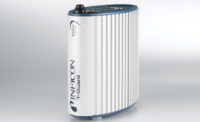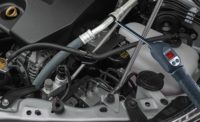Automotive manufacturing quality demands continue to increase along with pressure to further reduce costs, especially for critical components and systems that require leak testing. Traditional leak detection methods are no longer reliable enough, while vacuum testing with helium is often too expensive and provides unnecessarily detailed results. An automated helium leak test that does not require a vacuum chamber, however, is an alternative that meets both cost and quality requirements.
Pressure and bubble testing no longer accurate enough
Most fluid containers in automobiles, trucks and motorcycles have traditionally been tested for leaks either in a water bath or with a pressure decay test. Both are relatively low-cost tests but can be used only up to a detection limit of 10-2 to 10-3 mbar l/s.
Smaller leaks cannot be measured with bubble tests in water since bubbles will not form due to the high surface tension of water. The leak rate limit for air-conditioning components and fuel tanks is 10-5 mbar l/s and 10-4 mbar l/s for injection valves. In addition, some components cannot be placed in water, and as a purely visual check, test results depend entirely on the ability and attention of the person performing the test.
In the pressure decay method (or differential pressure test) air is introduced into the test part at a specific pressure. If there is a leak, the pressure drops and the difference can be measured. Simple in theory, the method in practice must take into account a variety of variables.
Pressure changes, for example, are not necessarily caused by leaks. There may be elastic changes in the test part. When air is introduced rapidly into the test part, the part expands and then contracts. Since the difference to be measured depends on pressure and volume, it is necessary to wait until the test sample has reached its original volume (stabilization phase). The greater the original volume and pressure during the introduction of air, the longer the required stabilization phase is.
Under normal production conditions, the volume limit for parts is about five liters. Furthermore, if the stabilization phase is too long, the test is no longer cost-effective. In addition, when air is introduced into plastic test parts, a “creep” effect has to be taken into consideration (the plastic deformation of the test part under load). During the test period (especially for long testing times), the volume of the test part may increase depending on the molecular composition of the plastic, and as pressure decays, a reliable measurement of small leak rates is virtually impossible.
Pressure changes considerably based on temperature as well. At a test pressure of five bar, a test volume of one liter and a test time of 30 seconds, a temperature drop of just 0.1°C generates a virtual leak rate of 6*10-2 mbar l/s. On the other hand, if the temperature rises by 0.1°C, leaks up to a leak rate of 6*10-2 mbar l/s would not be displayed, since a temperature-related pressure increase in the test part would be offset by pressure decay, due to the leak itself.
Production processes also cause many vehicle components to come off of the production line warm. Cooling during testing will affect the detection process. A longer stabilization phase will fix the problem but time is always a cost factor. A cooling section could be built into the system but would increase test times and overhead costs.
Ambient temperatures may also present a problem, especially in the Asia-Pacific region or Latin America, where temperatures in production facilities often vary considerably throughout the day. Temperature fluctuations can have a significant impact on test results. High temperatures are problematic in general. Humidity will also affect results due to the pressure of water vapor in the surrounding air. Variations in heat and humidity generally occur in low-cost production facilities.
Constructing test areas to meet these challenges, however, is difficult and often offsets other regional cost benefits. The important reproducibility of measurement results is difficult to ensure and continues to decline with smaller leak rates or increasing volumes. The pressure decay method, therefore, is no longer accurate enough in many cases to meet many auto component test requirements and generally can no longer be used effectively in certain regions of the world.
In summary, traditional leak detection methods such as bubble or pressure testing for a variety of components no longer meet current auto industry quality or cost requirements.
Vacuum test methods are expensive
There are other test methods that detect leaks with a mass spectrometer using helium as a test gas. Although the smallest amounts of helium and the smallest leak rates can be detected (10-11 mbar l/s), detection of helium gas with a mass spectrometer requires high vacuum levels and increases costs.
Vacuum chambers that are extremely leak-tight with high-performance pumps are expensive to build and operate. Their use makes sense if extremely small leak rates need to be detected. Testing only takes a few seconds and today’s systems are so highly developed that they can deliver optimal detection for several test cycles, even with a steadily increasing helium concentration (base).
Acquisition and operating costs for mass-spectrometer systems, however, may outweigh their benefits. Detection levels, for example, may exceed component test requirements by a factor of 1,000 or more. In addition, evacuating the chamber at a high vacuum for the test sample always means a differential pressure of more than one bar. Many plastic parts are not designed for such high pressures and would collapse.
The plastic test sample, therefore, would have to first be evacuated along with the surrounding chamber to keep the differential pressure to almost zero before filling with helium at a low pressure. This requires additional pump sets to pump down the interior of the part.
In addition, with large-volume test samples such as fuel tanks and other components, the volume of the test chamber must be correspondingly large. On the one hand, the pump time for evacuation of the test chamber increases as well as the overall test time. Investment costs also rise because of the larger installation. In an automotive industry geared toward cost efficiency and productivity, such increases are difficult to justify.
The alternative: integrated helium leak detection without a vacuum
In the automotive industry, testing with air has in many respects reached its limits and testing in a vacuum is too expensive. In the 10-2 to 10-5 mbar l/s range there is a considerable need for high-performance, automated test methods. An economical method to meet this need is a leak detection test with helium or hydrogen in an accumulation chamber at normal pressure (accumulation method).
Hydrogen, a forming gas with a 5% hydrogen fraction, can be used just as well as helium. Hydrogen is more reasonably priced as a test gas than helium (about one-seventh the price), but does not provide the same sensitivity. For smaller leak rates, 10-3 mbar l/s for example, and with a net volume of 10 liters, the test time is about five minutes (compared to helium: 11 seconds).
With regard to test scenarios, the hydrogen test corresponds more closely to a pressure decay test, but without its disadvantages in terms of elasticity and temperature. Helium is also suitable for the testing of leak rates from 10-4 to 10-5 mbar l/s. Since a mass spectrometer cannot be used at normal pressure, a highly sensitive sensor which can be used at atmospheric pressure is required for this method.
Sensors based on new technology available today, for example, can measure an increasing helium concentration in a test chamber at atmospheric pressure. In the chamber helium is introduced into the test part through its test-gas connection, so the test gas can escape through any leaks into the accumulation chamber.
Fans ensure an even distribution of helium in the chamber—thus ensuring precise measurements independent of the position of the leak. The sensor determines the test gas content in this atmosphere. In the case of this new system, the sensor consists of an evacuated glass tube with a helium-permeable quartz membrane on its upper side.
The membrane is like a sponge interspersed with small capillaries through which only helium at a molecular level can penetrate. Through a change in the helium concentration in the glass tube, a current flows into the attached pressure measuring device. In this way, the sensor is able to distinguish increases in concentration of 25 ppb or 0.025 ppm. Leaks, therefore, can be reliably detected in a range of 10-6 mbar l/s under test conditions.
With a free volume (free volume means the volume of the chamber minus the volume of the test sample) of five liters in the test chamber, leak rates of 1*10-4 mbar l/s can be determined within about 30 seconds. With a volume of one liter, the same leak rates can be detected in just 11 seconds. Including set-up time, the result is about 16 seconds per test sample or 225 test samples an hour.
As an example, exhaust-recirculation systems are tested with this method for inner and outer leak-tightness against a leak rate of two sccm, equivalent to 3.3 * 10-2 mbar l/s. In a 40-liter test chamber with a 10% helium-air mixture as the test gas, it is possible to produce test times of 11 seconds and total cycle times of 45 seconds per part. Besides speed, this method offers a further advantage: test samples made of plastic also can be tested without problem. Expanded test-sample volume during the introduction of gas is not a factor. Temperature, humidity and elasticity also are irrelevant. To check the system, measurements are made against a test leak that meets the required leak-rate limit. By positioning the test leak at various places in the test chamber, it’s also possible to check if a uniform helium concentration has actually been attained in the test chamber.
Sensor and system
Sensitivity is not the only important factor in a leak detection system. For easy integration, individualized set-up and low-maintenance, a test system also must have a simple, compact design that can be optimally connected to hydraulic, as well as electronic components that permit a wide variety of test modes. Here the accumulation method has a significant advantage.
Since the atmosphere within the test chamber does not have to be evacuated, the need for turbomolecular pumps and extremely leak-tight vacuum chambers is eliminated along with the need for a sensitive mass spectrometer. The test system can thus have a comparatively simple design. Acquisition and maintenance costs for the entire system are both manageable and low. Successful tests with reliable, reproducible measurement results also are possible, even with the simplest household plastic boxes. Nevertheless, the test results for this integrated helium leak detection test variant is highly reproducible and reliable, even with large, warm or moist test samples.
Long cooling and drying phases are no longer necessary before testing as well. Helium leak detection without a vacuum, therefore, is ideally suitable for testing automotive components, where rapid, automated production-line testing is critically important. This type of system, with its highly sensitive helium sensor and accumulation chamber, meets auto industry demands for quality in a reasonable and cost-effective way.














